How to Design a Xeriscape Garden That Thrives in Drought
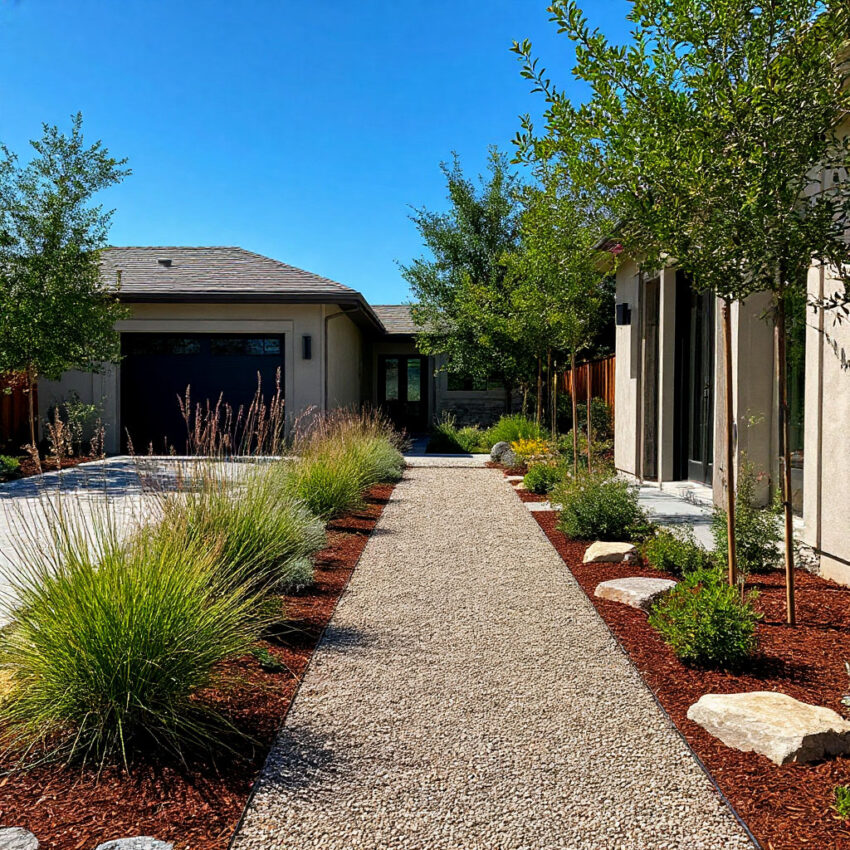
Designing a drought-ready yard in the United States isn’t a niche hobby anymore. Water bills keep rising, summers run longer, and lawns struggle under heat waves. A xeriscape garden USA uses smart design to cut irrigation needs while keeping curb appeal strong. At its core, xeriscaping means matching plants, soil prep, and hardscape to local climate and watering realities. The result is a resilient landscape that looks good year-round and doesn’t guzzle resources.
A xeriscape garden USA follows seven big ideas: plan with climate in mind, improve soil only where it pays off, group plants by water needs, use mulch to lock in moisture, choose efficient irrigation, reduce turf, and maintain lightly. This approach sets up clean anchors for later sections like soil prep, mulching, and regional plant picks. The method works for tiny patios and sprawling front lawns alike. It also supports city goals around water conservation without sacrificing style.
Homeowners ask how to build a xeriscape garden without losing color or seasonal interest. The answer starts with structure: bones, layers, and accents. Low berms, gravel bands, and deep mulch create a backbone. Shrubs, perennials, and groundcovers fill visual layers. Accent pieces—boulders, corten planters, or a simple steel edge—finish the look with minimal upkeep.
A good plan picks lanes for people and another for water. Walkways define circulation, while contouring and swales guide rain into the root zone. With that setup, a xeriscape garden USA keeps stormwater working onsite rather than sliding into the street. This is landscape as infrastructure, wrapped in a calm, modern vibe. At the end of this guide you’ll find a downloadable, ready-to-print checklist that condenses all key steps for building a xeriscape garden USA with minimal water use and maximum curb appeal.
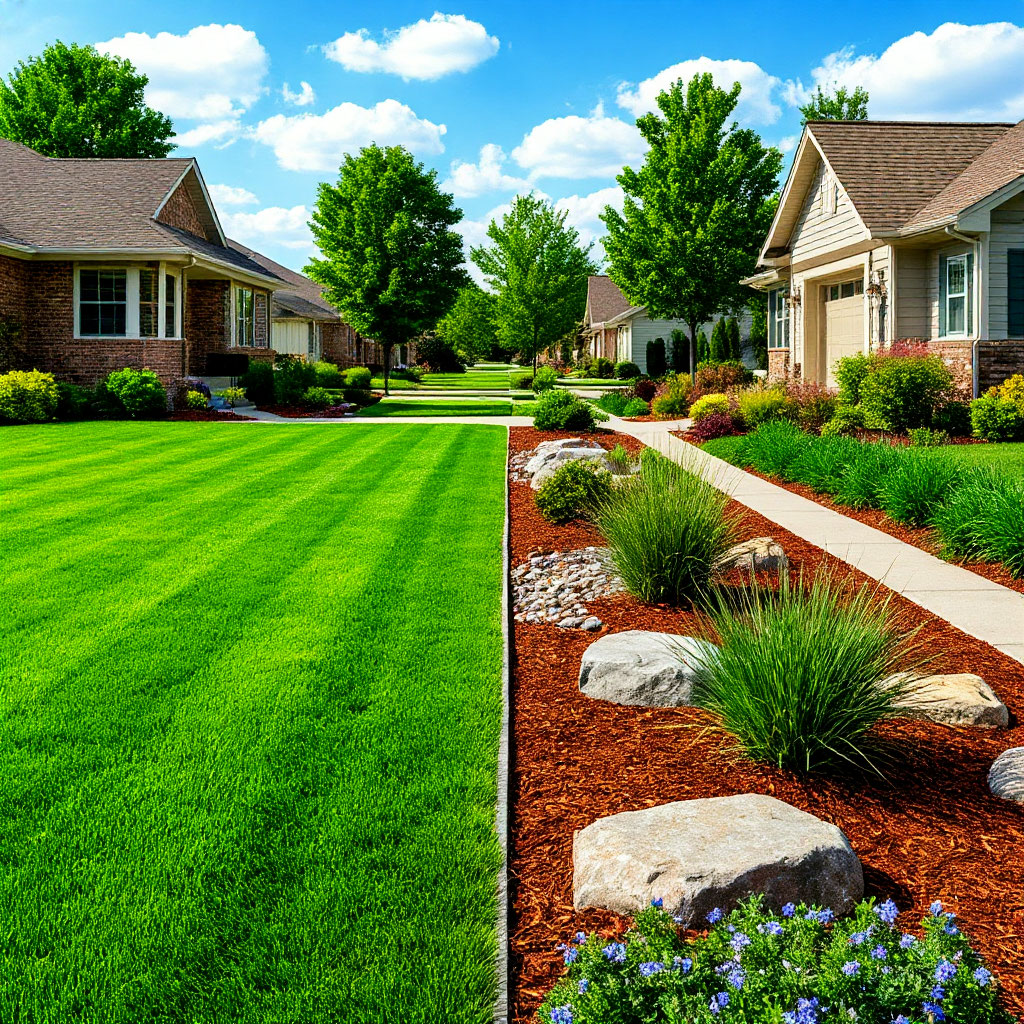
What Is Xeriscaping and Why It Matters in 2025
Xeriscaping means designing for water efficiency without giving up comfort or beauty. The goal is balance: cool shade, tidy lines, and plants that can take the heat. The big picture fits any region, but the species list changes by climate. Homeowners keep more cash in their pocket while cutting maintenance time. That combination makes adoption fast across suburbs and city blocks.
Climate Challenges in American Yards
Heat records keep falling across much of the country. Western states feel the pinch longest, but the Southeast and Mid-Atlantic face summer dry spells more often. Towns respond with tiered water pricing and seasonal restrictions. That pressure turns classic turf into a costly habit. Many owners start comparing xeriscape vs lawn and find the water savings hard to ignore.
A second driver is resiliency during drought emergencies. Neighborhoods that leaned into drought-tolerant landscaping stayed greener on tight watering schedules. That point gets attention from HOAs and city planners as codes slowly shift. Homeowners also notice the habitat boost for pollinators. That’s where native plants xeriscaping enters the chat and makes yard care simpler.
Municipal data backs up the move. Studies in arid metros show outdoor use can drop 30–60% with smart conversions. Those numbers carry to mixed climates with smaller but still real savings. That trend supports climate-friendly landscaping standards now written into planning docs. Buyers see it on listings and appraisals, which nudges demand further. A large evaluation by the Metropolitan Water District reported average long-term savings of roughly 44 gallons per square foot annually after turf replacement (2019, Southern California).
In 2025, a water-wise plan isn’t a trend; it’s plain common sense. The design shifts once, then pays dividends for years.

Best Plants for Low-Water Landscaping
The right plant list is the backbone of any water-thrifty yard. Species should match USDA zones, sun hours, and soil texture. Structure plants set form; fillers handle color and bloom timing. Groundcovers tie it all together, keeping weeds down and moisture steady. Thoughtful layering beats random shopping every time.
Native Options by Region
Regional natives bring built-in toughness and wildlife value. In the Southwest, velvet sage, desert spoon, and penstemon handle blistering sun with poise. The Southern Plains lean on little bluestem, mealycup sage, and aromatic aster. Mid-Atlantic sites perform with butterfly weed, seaside goldenrod, and switchgrass. Each region offers evergreen anchors to hold winter shape.
Gardeners comparing plant lists often ask about drought-resistant plants USA for mixed soils. Many native bunchgrasses and salvias adapt well when drainage is fair. Grouping by hydrozone makes irrigation straightforward. Light drip lines support new roots, then runtime drops after establishment. This beats guesswork and reduces waste on sidewalks or fences. A multi-year University of California Davis study showed native and Mediterranean plant palettes maintained quality at 20–30% lower irrigation than typical ornamental mixes (2015, California).
Residents who want a greener look in hot states explore desert landscaping USA without going full cactus patch. Soft textures like feathery cassia and blue grama add motion. Pale gravel or decomposed granite underlines foliage color and reflects moonlight for evening use. The effect is calm and low-maintenance through peak heat.
“Right plant, right place.” — Beth Chatto, garden designer and author. Her mantra keeps choices grounded in site conditions rather than catalog photos.
Group plants by hydrozone and feed each zone with its own drip line and schedule.
Bullet list—regional plant pick cues:
- Match plant heat tolerance to your hottest week, not your average summer.
- Check mature width first to avoid hedge trimmers running all season.
- Layer evergreen structure, then add long-bloom perennials for color beats.
- Use groundcovers to cool soil and limit irrigation losses.
- Confirm deer pressure and swap sensitive plants before buying.
Start local, layer smart, water to establish, and the palette will reward steady growth with fewer chores.
Ornamental Yet Resilient Picks
Tough doesn’t mean dull. Globe mallow, rockrose, and yarrow bring long bloom windows. Hesperaloe and agave add sculpture you can see from the street. In cooler zones, Russian sage and catmint keep pollinators busy for months. The trick is mixing textures so the bed looks fresh between peak flowers.
Nurseries now label benches with low-water plants USA, making shopping quicker. A label helps, but site conditions still rule. Sun exposure, reflected heat from paving, and wind all change the outcome. Owners who log these details pick winners more often. It’s a small habit with big results.
“Plant the rain, then plant the plants.” — Brad Lancaster, rainwater harvesting educator. Catch water on site first, then place species where that moisture lingers.
Front-of-house projects benefit from tidy bones as well. That’s where people search for xeriscape front yard ideas to lift curb appeal. A narrow gravel band, a crisp steel edge, and evergreen mounds give a tailored feel. Add a single accent tree to set height and shade the entry path by late afternoon. A Denver Water xeriscape pilot documented landscape water use reductions between 30% and 50% after turf removal and hydrozoning (2016, Colorado).
A resilient plant list doesn’t read like a compromise. It reads like good taste that lasts through August.
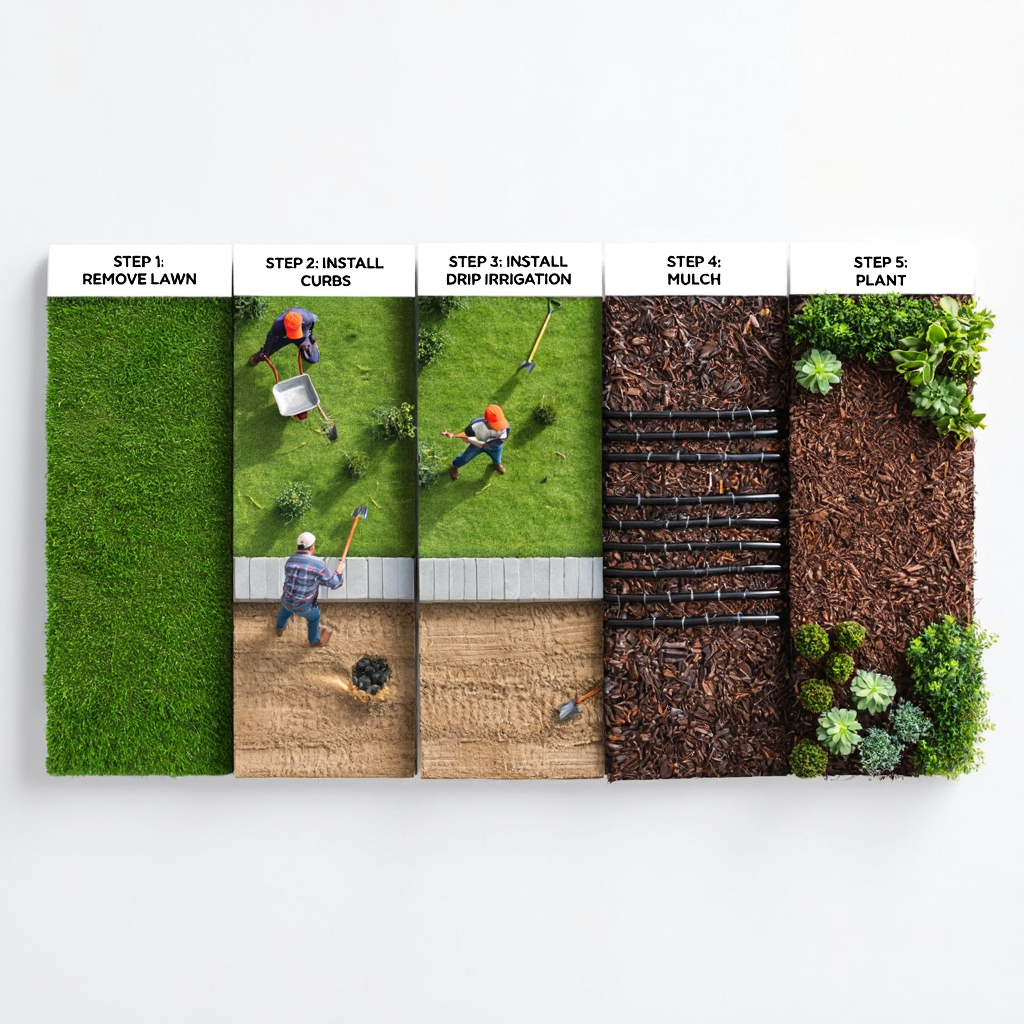
Step-by-Step Guide to Creating a Xeriscape Yard
A clear plan prevents costly redos. Start with a measured base map, note sun paths, and track downspouts. Mark slopes and any soggy zone after heavy rain. Then set priorities: seating, views, and easy access to gates or trash pull-out. The plan builds from that list.
“If you can’t measure it, you can’t manage it.” — Peter Drucker, management consultant. Apply the idea to irrigation: track runtime and adjust by data, not hunch.
Soil Prep and Mulching
Most xeric plants want drainage, not rich soup. In heavy clay, fix grading and add coarse material in planting trenches. In sandy soils, use compost to hold nutrients during the first seasons. After planting, cover soil with three inches of natural mulch. Keep a clean ring around stems to prevent rot.
Mulch reduces evaporation, buffers soil temps, and softens footfall. That’s the quickest upgrade for a xeriscape garden USA on a budget. Drip lines under mulch deliver water where roots need it. A once-per-week cycle in the first season usually does the trick, then taper down. Spot-check moisture with a probe rather than guessing. Utah State University Extension field work found smart controllers and proper mulch depth cut irrigation by 20–40% while preserving plant quality (2012, Utah).
Measure water in minutes and inches, then adjust by soil feel and plant response rather than by calendar.
Owners exploring sustainable garden design often add shallow swales to slow stormwater. These gentle channels redirect roof flow to plant basins. Borders of cobble or chunkier gravel prevent washouts during cloudbursts. A small change like that keeps irrigation minutes lower through summer.
Prep smart, mulch deep, and water with intention. The rest of the work gets easier.
Rock and Hardscape Integration
Stone, steel, and gravel do more than decorate. They shape movement, direct water, and reduce maintenance. A gravel patio drinks rain instead of pooling it. A steel edge holds planting lines crisp for years. Large boulders anchor corners and create microclimates that shield young perennials.
Designers published strong modern xeriscape ideas that blend crushed stone with warm wood. The contrast reads current without fighting older architecture. Permeable paths and stepping pads keep shoes clean and invite evening walks. Lighting at knee height guides the way without glare.
Budget plans often start as yard conversion xeriscape phases. Phase one removes the thirstiest turf and sets main paths. Phase two adds trees and shrubs with drip. Phase three finishes groundcovers and accent pieces. Phasing spreads costs while keeping the yard usable at each step.
Hardscape is the quiet star of water-wise yards. It sets the frame and keeps upkeep low.
Comparison Table — Installation Elements and Payoff
| Element | Typical Cost Range | Water Impact | Maintenance Load | Notes |
|---|---|---|---|---|
| Drip irrigation retrofit | $1.25–$2.50/sq ft | 25–40% less outdoor use vs spray | Low | Easiest win for older systems |
| Mulch at 3″ depth | $0.35–$0.75/sq ft | Cuts evaporation significantly | Low | Replenish lightly each spring |
| Permeable gravel patio | $6–$12/sq ft | Keeps rain onsite | Low | Good for DIY weekends |
| Turf removal & soil regrade | $1.50–$3.00/sq ft | Big saving where lawn was large | Medium | Needed before planting |
| Boulders & accent rock | $300–$900 each | None direct, boosts shade pockets | Very low | Choose local stone for fit |
Step-by-Step Instruction
- Water to establish: irrigate deeply once or twice weekly for the first season, then reduce gradually.
- Map the yard: use stakes, tape, and a long measure to outline boundaries and record slopes.
- Track sun and shade: observe how many hours of sunlight each section receives during peak summer.
- Remove turf: start with the driest or most expensive-to-irrigate zones, cutting water loss immediately.
- Set edges and grade: install steel, stone, or concrete edging and adjust soil levels before planting.
- Amend soil: add coarse sand or compost only where needed, matching plants to the soil type.
- Lay irrigation: convert sprays to drip, test emitters, and group plants by water need.
- Plant in hydrozones: arrange lowest water demand plants farthest out and higher demand near walkways.
- Mulch deeply: spread three inches of organic mulch, keeping clear space around stems.
- Check drainage: run the irrigation and confirm water soaks evenly without runoff.

Design Inspirations for Different Yard Sizes
Proper scale makes modest spaces feel larger and big lots feel ordered. Repeating materials ties zones together. A steady palette of plants keeps the eye calm. Accent only where it matters, like the entry path or a seating nook. Smart details beat big budgets.
Small Urban Backyards
Townhomes and cottages often have limited ground. Focus on one strong seating area with a shade sail or small pergola. Use narrow planting beds with layered perennials to keep walls softened. Mirrors or lattice panels bounce light and add height without crowding.
City dwellers browsing small yard xeriscaping often land on raised steel planters. These boxes warm fast in spring and drain well. They also deliver clear geometry that reads tidy from indoors. A slim water feature can mask street noise without cranking pumps. A Phoenix case series found small-lot rain gardens captured over 80% of a typical summer storm from roofs when graded correctly (2018, Arizona State University).
For tight front parcels, people search xeriscape front yard ideas that don’t feel stark. A gravel carpet with stepping pads, two structural shrubs, and a low accent tree checks the box. A single pop of seasonal color near the mailbox finishes the scene. Keep plant counts low to avoid clutter.
- Use one dominant surface material and a single edging style.
- Keep furniture scaled to human comfort, not patio size.
- Plant in drifts, not singles, for a calm read from the window.
- Hide irrigation under mulch to reduce visual noise.
- Cap the palette at three foliage colors plus one seasonal bloom.
Simple lines and a short plant list create a restful pocket that’s easy to care for.
Large Suburban Front Lawns
Big lots need structure and rhythm. Long gravel bands act like hallways linking driveway, porch, and side gates. Trees cast shade over paving to cool the microclimate. Plant masses repeat across the frontage so the home looks cohesive from the street.
Many owners evaluate xeriscape vs lawn when irrigation fees rise. Replacing half the turf with beds and paths often trims outdoor use by a third. Shade trees drop surface temps on summer afternoons. That comfort boost becomes obvious at barbecue time.
“Native plants support local food webs far better than non-native ornamentals.” — Douglas W. Tallamy, entomologist, University of Delaware. Plant choices feed butterflies and birds while keeping maintenance under control.
Homebuyers think about resale and browse water-wise garden ideas to keep the look inviting. Curved beds soften corners while still draining well. A tidy edge and a clear front walk say “welcome” without high upkeep. Mail carriers appreciate the clean approach path too.
Set edges and grade before planting so traffic never crushes fresh roots.
Big yards don’t need big watering schedules. They need hierarchy, shade, and materials that breathe.
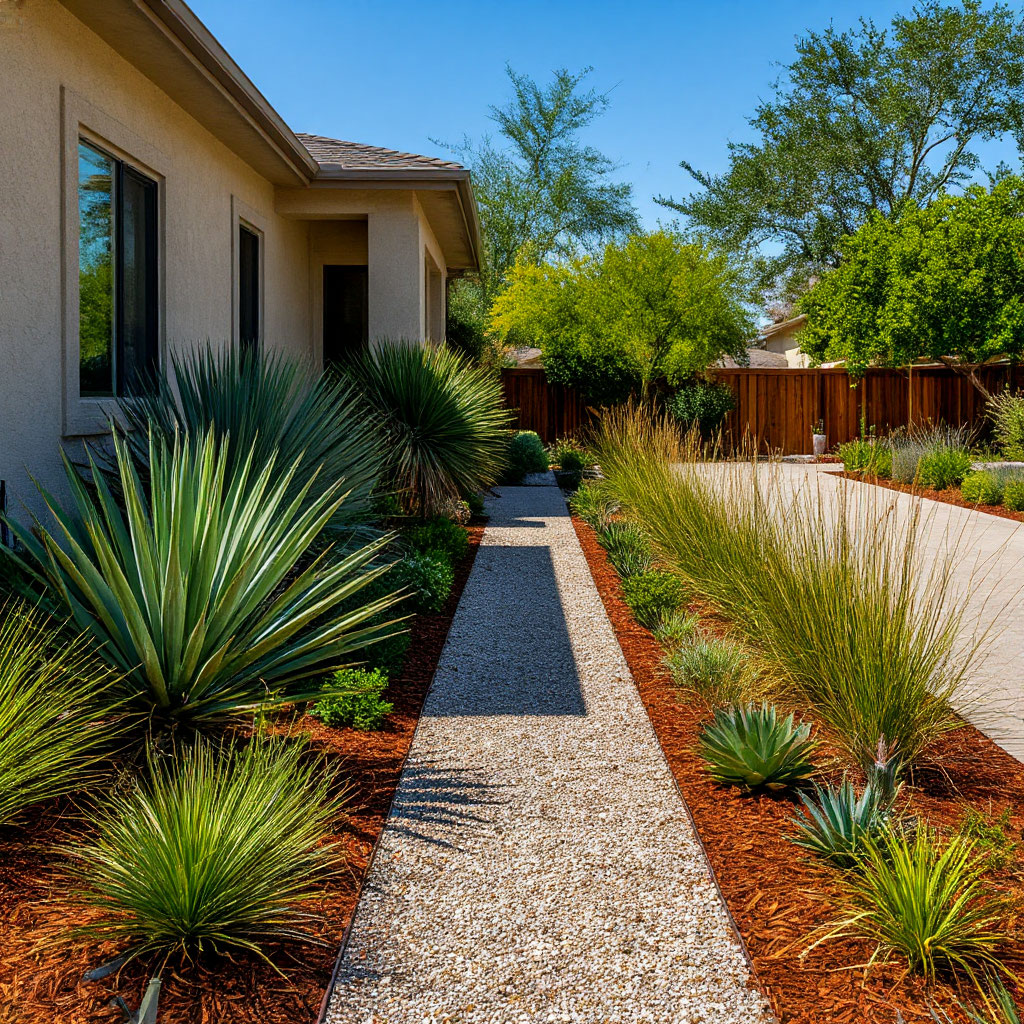
Maintenance and Long-Term Benefits
A well-built xeric yard requires less work, but it still needs oversight. Spring checks focus on emitter flow and mulch top-ups. Summer tasks are mainly weeding and trimming spent blooms. Fall resets the irrigation schedule as temps drop. Winter is quiet in most zones.
Water Savings and Costs
Case studies across western metros show outdoor cuts of 30–60% after conversion, with simple projects achieving the lower bound. Families often notice savings within the first two billing cycles. Systems with smart controllers and moisture sensors do even better. Those tools shave runtime without hurting plant health.
Owners researching affordable xeriscape design want payback timelines. A modest retrofit can recoup in three to five years depending on rates and lawn size. Rebates from city programs shorten that path. Check local water districts for current offers before starting. That single call can change the budget plan.
Many households also care about the look of turf. They test eco-friendly lawns built from drought-tolerant grass blends or native groundcovers. These alternatives need far less irrigation and fewer chemical inputs. The feel underfoot remains pleasant for play and pets. Edges stay sharper with steel or concrete curbs.
Smarter irrigation plus rebates make the numbers work. The yard stays comfortable while bills trend down.
Boosting Property Value
Appraisers now note water-wise features in many markets. Mature trees, clean hardscape, and regional plantings show well at showings. Buyers like the promise of lower bills and fewer Saturday chores. That story lands stronger than a thirsty blank slate.
Neighborhoods leaning into sustainable garden design see cohesive curb appeal. Shared plant palettes and repeating materials raise the visual baseline. Local pollinators thrive, which means more butterflies and songbirds around patios. The lifestyle factor helps listings stand out online.
Designers often compare climate-friendly landscaping choices during planning. Shade over paving lowers heat absorption and improves evening comfort. Permeable paths cut puddles after storms and reduce ice in winter. That combination boosts daily use and long-term durability.
Good design holds value. It reads as calm, efficient, and future-ready on day one and ten years later.
FAQ
How to build a xeriscape garden from scratch?
Start with a measured sketch and mark sun, wind, and runoff. Remove or reduce turf in the driest spots first. Add drip, mulch to three inches, and plant in groups by water need. Finish with edges and gravel paths that keep lines tidy through the seasons.
Why does plant selection matter most?
Plants set water demand for the next decade. Pick regional natives and proven ornamentals that match your soil and sun. Grouping by hydrozone simplifies irrigation settings. Fewer mismatches mean fewer replacements after hot spells.
What’s better near the facade: stone or mulch?
Stone lasts longer and handles runoff better near downspouts. Mulch cools soil and feeds micro-life around perennials. Many front yards mix both: mulch in beds for growth, gravel in high-traffic strips. The blend looks tailored and performs well.
Before the wrap-up, watch this step-by-step walkthrough that turns the plan into action. It shows how to build a xeriscape garden USA with clear moves—site mapping, hydrozoning, drip setup, and mulching—so you can follow along in your own yard.
Use informational search terms when planning, like “how to build a xeriscape garden” to gather step-by-step guides. For hiring help or bids, try a commercial query such as “affordable xeriscape designers near me” and compare at least three proposals. Local nurseries often keep lists of contractors who know regional soils and water districts.
A water-wise landscape is a design choice that pays off in comfort, savings, and style. Thoughtful planning, smart soil prep, and region-matched plants do the heavy lifting. Mulch, drip, and permeable hardscape keep the system efficient with light upkeep. A xeriscape garden USA doesn’t read as sparse; it reads as confident and calm through the hottest weeks.
Ready to start? Walk the yard right after a rain and trace where water moves. Mark your best seating zone, set a simple plant palette, and phase the work to fit budget and time. That path leads to a xeriscape garden USA that holds up to heat without constant hose duty.
Before you wrap up, grab the printable checklist. It turns the whole plan into a quick on-site reference you can keep on your phone or clip to a clipboard while building your xeriscape garden USA. This one-pager keeps you from missing steps that cost time and water later. Every box ties to a proven move: proper grading, true hydrozones, and 3″ mulch. With it, you’ll pace the project, spend less on irrigation, and get a cleaner, longer-lasting finish.
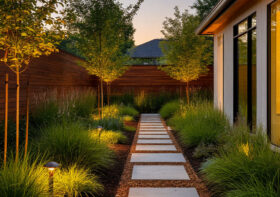
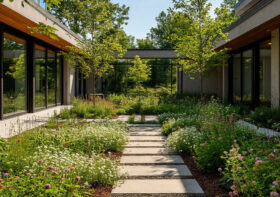

Leave a Reply